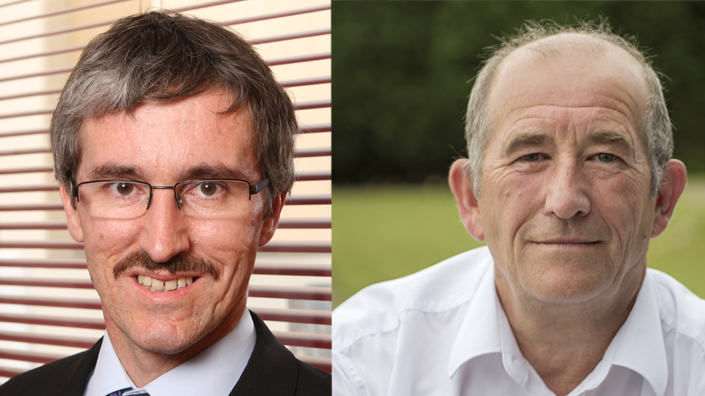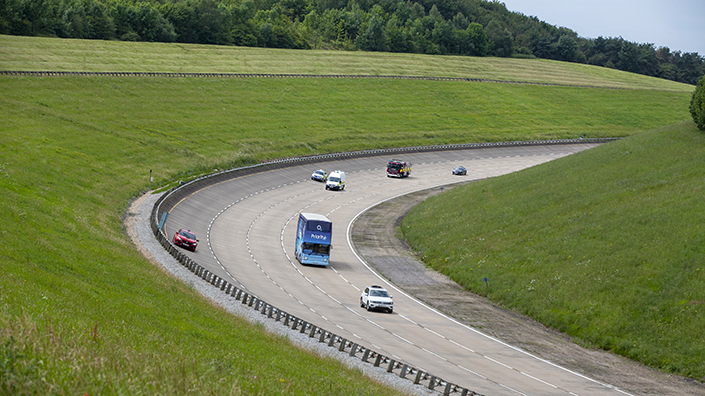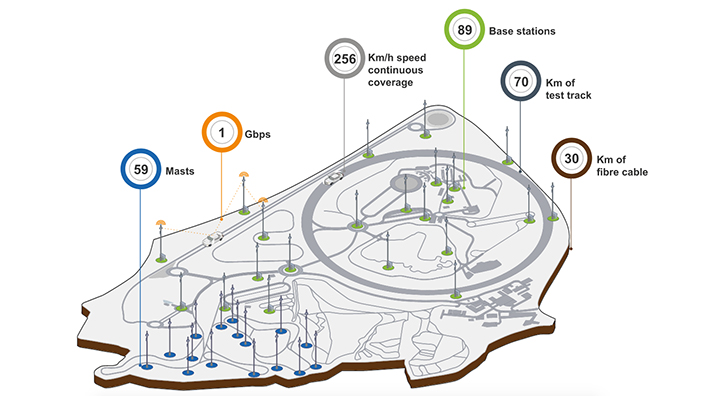Alpine routes wind through trees and over hills. Rough off-road sections test the durability of even the toughest vehicles.
This is not the Center Parcs holiday village – that is just to the south – but Millbrook Proving Ground, the UK’s premier automotive test facility. Established in the mid-1960s by General Motors, the centre has 70km of track, with every type of surface imaginable. The hilly and off-road sections join to a vast, high-speed loop to put vehicles through their paces.
And now, standing at the side of the track, are 59 masts beaming ultra-low latency 5G mobile data across the site, fed by 19km of fibre. The infrastructure is part of the AutoAir 5G testbed, a project aiming to develop the mobile data technology and explore its applications for the automotive sector and beyond.
The next-generation network will enable huge advances in vehicle connectivity and autonomy, but – as with 4G – its full capabilities will not be reached for years. Some of its ultimate applications are not even at the drawing board stage, says AutoAir project director Peter Claydon, but engineers from the testbed and its customers are starting to tap that boundless potential.
This is where the future of 5G could be determined.
‘Not the usual suspects’
The AutoAir project is led by two Peters – Claydon, a radio engineer involved in wireless infrastructure since the start of 3G, and Stoker, Millbrook’s chief engineer for connected and autonomous vehicles. The Airspan Networks-led testbed launched in February 2019, less than a year after receiving an initial year’s funding of £7m. It joined the controlled urban testbed for connected and autonomous vehicles at Millbrook, which started in 2017 and saw major investment in facilities, including a large simulation suite.

Peter Claydon (left) and Peter Stoker lead the 5G testbed at Millbrook
Although the urban testbed included ‘ideas’ for connectivity, they were not realised until the start of the 5G testbed. Airspan provided the infrastructure, installing a hyper-dense network across the site that is ‘saturated’ with small cells.
The ultra-reliable, low-latency, high-speed network has attracted many different customers, who often visit for testing, leave to develop new iterations and then return. “They’re not the usual suspects, the vehicle makers at this point,” says Stoker. “We tend to find that we’re dealing with software developers, AI authors, ‘machine learnists’… who might not necessarily have a great grasp in automotive engineering as a background, so we have to help them get on the tracks.”
Engineers have eagerly embraced the efficiency advantages on offer. Vehicles transmit near-instantaneous data from the track, enabling immediate analysis. Issues are solved on the fly, and the timeframe for test reports is massively shortened. This way of working will soon transfer to manufacturers and regulators, letting them monitor real-world data to improve vehicles and traffic systems.
Fast data, fast cars
One of the testbed’s most impressive features was instigated by consortium partner Blu Wireless, which came to Stoker with a challenge: “What we’d like to do is achieve a download speed of 1 gigabit per second (Gbps) at 160.”
Stoker says: “Now, being a dyed-in-the-wool car guy, I would immediately convert 160 to 100mph, because people these days talk in kilometres. But no, it was 160mph.”
The infrastructure was installed and McLaren supplied the car, which was driven around the Millbrook loop to enable such high speeds for a sustained period. The 1Gbps challenge was a success, and one immediate beneficiary is the rail sector.
“One of the big problems with communicating with trains is handing over from one access point to the next,” says Claydon. Infrastructure is expensive, so might only be installed over one mile – not significant on a typical railway line. If there are any issues with the transmitters, the window for testing becomes even tighter. At Millbrook, on the other hand, “you can drive around and around the high-speed bowl as many times as you like. You can do a 100-mile ‘train journey’ if you want,” says Claydon. After proving that the technology can work, Blu Wireless is now trialling it with First Group trains between Clapham Junction and Basingstoke.

Vehicles transmit near-instantaneous data from the track, enabling immediate analysis
The high-speed connectivity also enabled a trial with the East of England NHS, which installed high-quality video cameras on its ambulances for tests at Millbrook. The vehicles relayed live video to a hospital consultant at a remote site, enabling diagnosis and prescription of medicines. Time is of the essence with medical conditions such as strokes, so the system could save lives.
Such connectivity will be available relatively soon, but what comes after could have an even more significant impact on the future of transport – autonomy.
Just six days before the launch of the 5G testbed in February 2019, autonomous vehicles made national headlines after a government announcement.
“The UK has a rich heritage in automotive development and manufacturing, with automated and electric vehicles set to transform the way we all live our lives,” said the then automotive minister Richard Harrington. “We need to ensure we take the public with us as we move towards having self-driving cars on our roads by 2021.”
Moving target
With that target now just months away, it seems very unlikely to be met. “It’s a bit further down the road, I think, than everybody initially expected,” says Stoker.
Companies working at Millbrook are nonetheless at the leading edge, aided by the world-leading connectivity on offer. Of course, autonomy means autonomy – self-driving cars must control themselves and interact with other vehicles without reliance on external technology. 5G could bring extra safety, security and continuous improvements, however, as well as ‘infotainment’ for passengers.

Engineers use the network to make changes on the fly
High-speed data will augment vehicles’ sensors. An autonomous car needs to know for itself if the vehicle in front of it has stopped, but it will ‘see around corners’ thanks to vehicle-to-vehicle and mast-to-vehicle messages arriving in mere milliseconds, leaving plenty of time for braking distance even if a road blockage is out of sight.
Another potential application could be tele-operation of driverless cars in the event of an accident or sensor failure, especially if the vehicle has no safety driver – or even, one day, no steering wheel. Start-up Imperium Drive is testing the technology at Millbrook, remotely controlling cars over the network from hundreds of metres away.
The instantaneous analysis already enjoyed by engineers at Millbrook will transfer to regulators, letting them keep a close eye and collect data from incidents. 5G connectivity will also enable 4K video transfer between autonomous vehicles, such as tightly-packed lorries in autonomous ‘platoons’ to reduce fuel use.
Front of the pack
With so many applications in transport and beyond, the 5G work at Millbrook will inform governments and operators on best practice and help secure the UK as a world leader.
It is difficult to overstate the scale of a nationwide roll-out. 5G waves have higher ‘path loss’ than other radio waves and so do not travel as far, requiring a denser network of transmitters.
Tricks practised at Millbrook will make it more efficient, however. Thanks to work by consortium member Telefonica O2, the testbed network is one of the first to trial ‘slicing’ and ‘neutral hosting’ of masts, allowing multiple operators to share one set of hardware – unlike 4G, where each operator needs a mast.

59 masts are dotted around the 70km test tracks (Credit: Maxine Heath)
Mobile companies, transport authorities and car manufacturers could each pay for a portion of infrastructure in future. Lower frequencies are also likely to be ‘refarmed’ as 5G frequencies.
Millbrook has also shown how seemingly small changes can have a big effect. Blu Wireless boosted the network frequency from 60GHz to 70GHz, to prevent oxygen absorbing too much of the signal. Doing so doubled the range.
That is “very significant,” says Stoker. “You could, in theory, halve the infrastructure… if you scale that up to national coverage, by adjusting the frequency in which all this operates, you can make massive savings.”
‘Nobody gets hurt’
As the two Peters talk from home during the coronavirus lockdown, 5G is in the news for less positive reasons. New masts are smouldering around the country, following arson attacks linked to the dangerous and untrue conspiracy blaming the technology for Covid-19. The people complaining will probably stop when they experience the benefits, says Claydon – and even the experts don’t know all of them.
Future work at Millbrook holds many exciting possibilities, and Stoker is eager to get back to the track after lockdown. He brings up something he would “love” to try, called ‘augmented testing’. “If you have a vehicle that’s learning how to deal with potential collision scenarios, the last thing you want to do is to have a real truck come around a blind bend in front of it.
“What I’d rather do is do the whole scenario in simulation first… with a virtual vehicle, a virtual truck and a virtual track. Nobody gets hurt, no metal gets bent.”
After proving the collision avoidance on the virtual vehicle, developers could replicate the scenario with a real vehicle on track – but still using a virtual truck, simulated in real time over the network. The virtual and real scenarios could then be correlated to improve the system further.
This innovative idea is a perfect example of the technology’s transformative potential. “We haven’t even started to scratch the surface of what’s possible,” says Stoker. “The tests and trials that we are doing illustrate the capabilities, but, once we get some more fertile imaginations on it, it’s just boundless really. We haven’t even discovered 1% of what we can do.”
Want the best engineering stories delivered straight to your inbox? The Professional Engineering newsletter gives you vital updates on the most cutting-edge engineering and exciting new job opportunities. To sign up, click here.
Content published by Professional Engineering does not necessarily represent the views of the Institution of Mechanical Engineers.